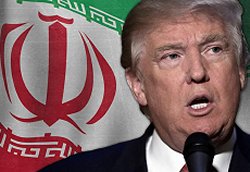
|
- Iran: Eight Prisoners Hanged on Drug Charges
- Daughter of late Iranian president jailed for ‘spreading lies’ - IRAN: Annual report on the death penalty 2016 - Taheri Facing the Death Penalty Again - Dedicated team seeking return of missing agent in Iran - Iran Arrests 2, Seizes Bibles During Catholic Crackdown
- Trump to welcome Netanyahu as Palestinians fear U.S. shift
- Details of Iran nuclear deal still secret as US-Tehran relations unravel - Will Trump's Next Iran Sanctions Target China's Banks? - Don’t ‘tear up’ the Iran deal. Let it fail on its own. - Iran Has Changed, But For The Worse - Iran nuclear deal ‘on life support,’ Priebus says
- Female Activist Criticizes Rouhani’s Failure to Protect Citizens
- Iran’s 1st female bodybuilder tells her story - Iranian lady becomes a Dollar Millionaire on Valentine’s Day - Two women arrested after being filmed riding motorbike in Iran - 43,000 Cases of Child Marriage in Iran - Woman Investigating Clinton Foundation Child Trafficking KILLED!
- Senior Senators, ex-US officials urge firm policy on Iran
- In backing Syria's Assad, Russia looks to outdo Iran - Six out of 10 People in France ‘Don’t Feel Safe Anywhere’ - The liberal narrative is in denial about Iran - Netanyahu urges Putin to block Iranian power corridor - Iran Poses ‘Greatest Long Term Threat’ To Mid-East Security |
Wednesday 09 June 2010We must not forget those imprisoned in IranTelegraph One year after the mass protests in Iran, Amnesty is launching a report highlighting those who remain in jail, writes Kate Allen. “The prisoner’s worst nightmare is the thought of being forgotten,” wrote Newsweek journalist Maziar Bahari after his release from Iran’s Evin prison. He was detained for 118 days after he reported on the demonstrations following Iran’s disputed election, one year ago this weekend. He fled the country after his release and was later sentenced, in absentia, to 13 years in prison and 74 lashes. Bahari was one of thousands of people – over 5,000 according to official statements but probably many more – who were arrested during the mass demonstrations which first erupted on June 13, 2009. Most have now been released, often after suffering torture including beatings, rape and solitary confinement in small spaces for long periods. Some have returned to prison to begin serving custodial sentences, usually after being convicted in unfair trials on the basis of “confessions” that were forced out of them in detention. Most of those detained were ordinary Iranians who went out on the streets to protest against the announced election result. Some of them still languish in prison, particularly in the provinces away from the media spotlight in Tehran. But others were targeted because they were perceived to challenge the authorities’ legitimacy: they include human rights campaigners, students, women’s rights activists, academics, former political prisoners and their relatives, members of Iran’s ethnic and religious minorities, trade unionists, and lawyers who have defended political detainees. The net was cast wide. This repression is part of a wider pattern. Iran's authorities have criminalised contact with over 60 foreign institutions, media organisations and NGOs, isolating Iranians and preventing news, including on human rights violations, from leaving the country. Newspapers have been closed down, websites and email services have been filtered or blocked and the police have warned that SMS messages are monitored. University professors and staff have been fired on the grounds that they do not have sufficient “belief” in the Islamic Republic. Renewed efforts to implement “morality” codes concerning dress and gender segregation are underway which impede women’s ability to function freely in society. And numerous threatening statements have been issued, backed up by executions of political prisoners, to make it absolutely clear that those who express any form of dissent – whether by speaking out, writing or attending demonstrations – will face the harshest penalties. Even fleeing the country has not made people safe. Maziar Bahari recounted to Amnesty International how, on April 17 this year, one of his relatives in Iran received a threatening phone call. The person on the line said: “I’m calling from the court... Tell Maziar that he shouldn't think we don't have access to him because he is not in Iran… The situation is getting dangerous now. Anything can happen without advance notice”. Bahari’s profile ensured that he was not forgotten in jail. Some other detainees became similar causes célèbres – the film-maker Ja’far Manahi, for example, who was represented by an empty chair on the jury of this year’s Cannes film festival. But for others, the fear of being forgotten is a real one. That is one of the reasons why Amnesty International today launches “From Protest to Prison”, a report highlighting the plight of those in Iran who have been detained or remain in jail. The report aims to confront the Iranian authorities about the widespread human rights abuses that they are denying. We also hope to remind the international community that political considerations, including over Iran’s nuclear programme, should not lead to the country’s appalling human rights record being overlooked. But most of all it aims to bring to the public's attention the cases of prisoners who still remain in detention, and to mobilise people to demand their release. Maziar Bahari’s quotation has a particular resonance for us at Amnesty International. The British newspaper article by Peter Benenson that led to our foundation in 1961 was entitled “The Forgotten Prisoners”. It’s a sobering thought that nearly 50 years later, the same abuses are taking place and the need for public campaigning remains as pressing as ever. Kate Allen is the director of Amnesty International UK |

 Send to a Friend
Send to a Friend
